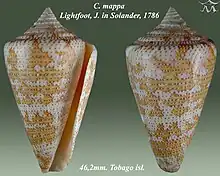Conus mappa
Conus mappa is a species of sea snail, a marine gastropod mollusk in the family Conidae, the cone snails and their allies.[1]
| Conus mappa | |
|---|---|
 | |
| Apertural and abapertural views of shell of Conus mappa Lightfoot, J. in Solander, 1786 | |
 | |
| Scientific classification | |
| Domain: | Eukaryota |
| Kingdom: | Animalia |
| Phylum: | Mollusca |
| Class: | Gastropoda |
| Subclass: | Caenogastropoda |
| Order: | Neogastropoda |
| Superfamily: | Conoidea |
| Family: | Conidae |
| Genus: | Conus |
| Species: | C. mappa |
| Binomial name | |
| Conus mappa Lightfoot, 1786 | |
| Synonyms[1] | |
| |
There are two recognized subspecies:
- Conus mappa jesusramirezi (Cossignani, 2010)
- Conus mappa trinitarius Hwass in Bruguière, 1792.[2]
- Conus mappa granarius Kiener, 1845.:[3] synonym of Conus granarius
The junior homonym Conus mappa Crosse, 1858 is a synonym of Conus eldredi Morrison, 1955.
Like all species within the genus Conus, these snails are predatory and venomous. They are capable of "stinging" humans, therefore live ones should be handled carefully or not at all.
Description
The size of the wide shell varies between 36 mm and 67 mm. The spire contains small nodules and has a smooth shoulder. The body whorl is smooth and has a very variable color pattern of milkish white to pinkish white with two spiral bands of greenish yellow to darker brown. These bands are broken into irregular patches. The spiral whorls show very fine longitudinal grooves. The aperture is whitish.[4][5]
Distribution
This species occurs in the Caribbean Sea off Venezuela, Trinidad - and Barbados where it occurs only at 85 fathoms/155 metres depth
References
- Conus mappa Lightfoot, 1786. Retrieved through: World Register of Marine Species on 7 August 2011.
- Conus mappa trinitarius Hwass in Bruguière, 1792. Retrieved through: World Register of Marine Species on 11 September 2011.
- Conus mappa granarius Kiener, 1845. Retrieved through: World Register of Marine Species on 11 September 2011.
- Henry E. Coomans, Conidae with smooth and granulated shells; Malacologia 14 (1973)
- Danker L.N. Vink and Rudo Von Cosel,.The Conus cedonulli complex: Historical review, taxonomy and biological observations; Revue suisse de zoologie t. 92 fasc. 3–4
- Holeman J; and Kohn A.J. (1970), The identity of Conus mappa (Lightfoot), C. insularis Gmelin, C. aurantius Hwass in Bruguière and Hwass's infraspecific taxa of C. cedonulii; Journal of Conchology 27 135:137
- Tucker J.K. & Tenorio M.J. (2013) Illustrated catalog of the living cone shells. 517 pp. Wellington, Florida: MdM Publishing.
- Puillandre N., Duda T.F., Meyer C., Olivera B.M. & Bouchet P. (2015). One, four or 100 genera? A new classification of the cone snails. Journal of Molluscan Studies. 81: 1–23
Gallery
 Conus mappa trinitarius Hwass in Bruguière, J.G., 1792
Conus mappa trinitarius Hwass in Bruguière, J.G., 1792 Conus mappa trinitarius Hwass in Bruguière, J.G., 1792
Conus mappa trinitarius Hwass in Bruguière, J.G., 1792
External links
- The Conus Biodiversity website
- "Tenorioconus mappa mappa". Gastropods.com. Retrieved 16 January 2019.
- "Tenorioconus mappa trinitarius". Gastropods.com. Retrieved 16 January 2019.
- Cone Shells – Knights of the Sea